Traces of Reciprocal Exchange: From Roman Pictorial Models to the World’s Earliest Depictions of Some Narrative Motifs in Andhra Reliefs
Abstract
1. Pictorial Motifs from the West in the Reliefs of Andhra
2. A Masterpiece of Art from Andhra and the Unidentified Narrative It Illustrates
rano sirisivamakasadasa ◊ pāniyagharikasa he ? /// mahāgovalavabālikaya ◊ [n]. /// (ka)ya ◊ sak(u)līgāya ◊ mahācetiye °utarāyāke ◊ °unisa dāna16
… he came to the house of an old woman who hid him away. From thence, after his body had been anointed with oil of mustard and sesame, and laid upon a bier as if had been a corpse, he was carried out to the cemetery and deposited there (…).The youth reached a hill-town, entered into the house of a dyer, and told him his story. So when his pursuers began to search the town, the dyer placed the youth in a clothes chest, which he set upon an ass, and took him out of the town to a bath-house, where he left him.
“A Serpent mighty, full of force, born on that mountain land,Caught me within his coils; and so here safe from death I stand.”(Jātaka, transl. vol. 4, p. 121)
The Yakṣa Pingala was sitting at a certain spot surrounded by his dogs (…). So he set the dogs on the youth. But the youth outstripped them and climbed up the tree.
3. The Lost Narrative in the Relief and Its Importance for the Narrative Motifs of Mankind
Funding
Conflicts of Interest
References
Primary Sources
Bodhisattvāvadānakalpalatā. Edited by P. L. Vaidya. 1959. Avadāna-Kalpalatā of Kṣemendra, 1–2. Durbhanga: The Mithila Institute.Dhammapadaṭṭhakathā. Translated by Eugene Watson Burlingame. 1921. Buddhist Legends, 1–3. Cambridge, MA: Harvard, Harvard Oriental Series 28–30.Jātaka. Translation and Edited by Edward B. Cowell. 1895–1907. The Jātaka or Stories of the Buddha’s Former Births, Translated from the Pāli by Various Hands, 1–6. Cambridge: Pali Text Society.Kathākośa. Translated by Charles Henry Tawney. 1895. The Kathākośa or, Treasury of Stories, transl. from Sanskrit Manuscripts. London: Royal Asiatic Society. Oriental Translation Fund, N.S. 2.Mūlasarvāstivādavinaya, Saṅghabhedavastu. The Tibetan Tripitaka: Peking edition kept in the Library of the Otani University, Kyoto. Reprinted under the supervision of the Otani University, vol. 42. Tokyo/Kyoto 1957.Taishō Shinshō Daizōkyō. Edited by Junjirō Takakusu, Kaigyoku Watanabe, and Genmyō Ono. Tokyo 1924–1934.Secondary Sources
- Aarne, Atti, and Stith Thompson. 1961. The Types of the Folktale, A Classification and Bibliography, Second Revision (FFC 184). Helsinki: Suomalainen tiedeakatemia. [Google Scholar]
- Aramaki, Noritoshi, D. Dayalan, and Maiko Nakanishi. 2011. A New Approach to the Origin of Mahāyānasūtra Movement on the Basis of Art Historical and Archaeological Evidence. A Preliminary Report on the Research. Project (C) no. 20520050. Tokyo: Grant-in-Aid for Scientific Research, The Japan Society for Promotion of Science. [Google Scholar]
- Asplund, Leif. 2013. The Textual History of Kavikumārāvadāna: The Relations between the Main Texts, Editions and Translations. Ph.D. dissertation, Stockholm University, Stockholm, Sweden. [Google Scholar]
- Bachhofer, Ludwig. 1929. Early Indian Sculpture. Paris: Pegasus. [Google Scholar]
- Begley, Vimala, and Richard Daniel De Puma, eds. 1991. Rome and India. The Ancient See Trade. Wisconsin: The University Press. [Google Scholar]
- Burgess, James. 1887. The Buddhist Stupas of Amaravati and Jaggayyapeta in the Krishna District, Madras Presidency, Surveyed in 1882. Archaeological Survey of Southern India 1. London: Trübner. [Google Scholar]
- Chavannes, Édouard. 1910–1934. Cinq cents contes et apologues, extraits du Tripiṭaka chinois et traduits en français. Paris: Leroux, pp. 1–4. [Google Scholar]
- Cimino, Rosa Maria, ed. 1994. Ancient Rome and India. Commercial and Cultural Contacts between the Roman World and India. New Delhi: Munshiram Manoharlal. [Google Scholar]
- Enzyklopädie des Märchens. 1977–2015. Enzyklopädie des Märchens. Handwörterbuch zur historischen und vergleichenden Erzählforschung. 1977–2015. Edited by Kurt Ranke, Rolf Wilhelm Brednich and Hermann Bausinger. Berlin and Boston: de Gruyter. [Google Scholar]
- Evers, Kasper Gronlund. 2017. Worlds Apart Trading Together: The Organisation of Long-Distance Trade between Rome and India in Antiquity. Oxford: Archaeopress Publishing Ltd. [Google Scholar]
- Gombrich, Ernst H. 1979. The Sense of Order. A Study in the Psychology of Decorative Art. New York: Cornell University Press. [Google Scholar]
- Hairman, Ann. 2012. Sleep well! Sleeping Practices in Buddhist Disciplinary Rules. Acta Orientalia Academiae Scientiarum Hungaricae 65: 427–44. [Google Scholar] [CrossRef]
- Hertel, Johannes. 1911. The Story of Merchant Campaka. Zeitschrift der Deutschen Morgenländischen Gesellschaft 65: 1–51, 425–70. [Google Scholar]
- Iversen, Margaret. 1993. Alois Riegel: History and Theory. Cambridge: MIT Press. [Google Scholar]
- Knox, Robert. 1992. Amaravati, Buddhist Sculpture from the Great Stūpa. London: British Museum Press. [Google Scholar]
- Koch, Margarete. 1965. Die Rückenfigur im Bild. Von der Antike bis zu Giotto. Recklinghausen: Aurel Bongers, Münstersche Studien zur Kunstgeschichte 2. [Google Scholar]
- LIMC. 1981–2009. LIMC Lexicon Iconographicum Mythologiae Classicae 1981–2009. Zurich and Munich: Artemis-Verlag. [Google Scholar]
- Longhurst, Albert Henry. 1938. The Buddhist Antiquities of Nāgārjunikoṇḍa, Madras Presidency. Memoirs of the Archaeological Survey of India 54. Delhi: Manager of Publications. [Google Scholar]
- McNally, Sheila. 1985. Ariadne and Others: Images of Sleep in Greek and Early Roman Art. Classical Antiquity 4: 152–92. [Google Scholar] [CrossRef] [PubMed]
- Parimoo, Ratan. 2002. Narrative Structure and the Significance of the Snake Jatakas in Buddhist Art. In Essence of Art and Culture: In Memory of Prof. Kalyan Kumar Ganguly. Edited by S. S. Biswas, Amita Ray, Deepak R. Das and Samir K. Mukhrejee. Delhi: Agam Kala Prakashan, pp. 31–40. [Google Scholar]
- Poonacha. 2011. Excavations at Kanaganahalli (Sannati, Dist. Gulbarga, Karnataka). Memoirs of the Archaeological Survey of India 106. Delhi: Archaeological Survey of India. [Google Scholar]
- Quagliotti, Anna Maria. 2009. Māyā’s Dream from India to Southeast Asia. In The Indian Night: Sleep and Dreams in Indian Culture. Edited by Claudine Bautze-Picron. New Delhi: Rupa, pp. 351–417. [Google Scholar]
- Rama, K. 1995. Buddhist Art of Nāgārjunakoṇḍa. Delhi: Delhi Sundeep Prakashan. [Google Scholar]
- Riegl, Alois. 1893. Stilfragen: Grundlegungen zu einer Geschichte der Ornamentik. Berlin: Siemens. [Google Scholar]
- Rockhill, William W. 1897. Tibetan Buddhist Birth-Stories; Extracts and Translations from Kanjur. Journal of the American Oriental Society 1897: 2–14. [Google Scholar]
- Schick, Josef. 1912. Das Glückskind mit dem Todesbrief. Orientalische Fassungen. Corpus Hamleticum: Hamlet in Sage und Dichtung, Kunst und Musik. Berlin: Emil Felber. [Google Scholar]
- Schiefner, Anton von. 1906. Tibetan Tales Derived from Indian Sources. Translated by William Ralston Sheddon-Ralston. Translated from the Tibetan of the Kah-Gyur. London: Trübner. [Google Scholar]
- Schlingloff, Dieter. 1987. Studies in the Ajanta Paintings, Identifications and Interpretations. New Delhi: Munshiram. [Google Scholar]
- Schlingloff, Dieter. 2000. Ajanta—Handbuch der Malereien/Handbook of the Paintings 1. Erzählende Wandmalereien/Narrative Wall-Paintings. Wiesbaden: Harrassowitz, pp. 1–3. [Google Scholar]
- Schlingloff, Dieter. 2013. Ajanta—Handbook of the Paintings 1. Narrative Wall-Paintings; New Delhi: IGNCA, pp. 1–3.
- Sivaramamurti, Calambur. 1942. Amaravati Sculptures in the Madras Government Museum = Bulletin of the Madras Government Museum; N.S. 4; Madras: Government Museum.
- Stern, Philippe, and Mireille Bénisti. 1961. Évolution du style indien d’Amarāvatī [Evolution of the Indian Style of Amarāvatī]. Publications du Musée Guimet, Recherches et documents d’art et d’archéologie, 7. Paris: Presses Universitaires de France. [Google Scholar]
- Stone, Elizabeth R. 1994. The Buddhist Art of Nāgārjunakoṇḍa. Buddhist Tradition Series 25. Delhi: Motilal Banarsidass. [Google Scholar]
- Stone, Elizabeth R. 2005. Spatial Conventions in the Art of Andhra Pradesh: Classical Influence? In Buddhism: Art, Architecture, Literature & Philosophy. Edited by G. Kamalakar and M. Veerender. Delhi: Sharada Publishing House, vol. 1, pp. 67–72. [Google Scholar]
- Stone, Elizabeth R. 2008a. The Adaptation of Western Motifs in the Art of Gandhara. In The Buddhist Heritage of Pakistan: Legends, Monasteries, and Paradise, Exhibition Catalogue. Edited by Dorothee Drachenfels and Christian Luczanits. Zurich and Mainz: Philipp von Zabern, pp. 80–85. [Google Scholar]
- Stone, Elizabeth R. 2008b. The Sculpture of Andhra Pradesh and Roman Imperial Imagery. In Krishnabhinandana: Archaeoogical, Historical and Cultural Studies, Festschrift to Dr. V. V. Krishna Sastry. Edited by P. Chenna Reddy. New Delhi: Research India Press, pp. 100–6. [Google Scholar]
- Stone, Elizabeth R. 2016. Reflections on Roman Art in Southern India. In Amaravati: The Art of an Early Buddhist Monument in Context. Edited by Akira Shimada Akira and Michael Willis. London: The British Museum, pp. 59–69. [Google Scholar]
- Stoye, Martina. 2006. ‘Māyā Anadyomene’—Die schöne Śākya-Fürstin beim Bade. Zum Import einer etablierten Bildformel in ein erzählendes Relief aus Amarāvatī. In Vanamālā, Festschrift Adalbert Gail. Edited by Klaus Bruhn and Gerd J. R. Mevissen. Berlin: Weidler, pp. 224–34. [Google Scholar]
- Stoye, Martina. 2008. Garuḍa and Ganymed. In The Buddhist Heritage of Pakistan: Legends, Monastries, and Paradise. Edited by Dorothee Drachenfels and Christian Luczanits. Zurich and Mainz: Philipp von Zabern, pp. 268–69. [Google Scholar]
- Tournier, Vincent. Forthcoming. Buddhist Nikāyas in Āndhra and Beyond: A Survey of the Epigraphic Evidence. In From Vijayapurī to Śrīkṣetra? The Beginnings of Buddhist Exchange across the Bay of Bengal. Edited by Arlo Griffiths, Alexey Kirichenko, Akira Shimada and Vincent Tournier. Paris: École Française d’Extrême-Orient.
- Vogel, Jean Philippe. 1937. The Man in the Well and some Other Subjects Illustrated at Nāgārjunikoṇḍa. Revue des Arts Asiatiques 11: 109–21. [Google Scholar]
- Weber, Albrecht. 1870. Über eine Episode im Jaimini-Bhārata (entsprechend einer Sage von Kaiser Heinrich III. und dem “Gang nach dem Eisenhammer”). In Monatsberichte der Königlich Preussischen Akademie der Wissenschaften zu Berlin. Berlin: Buchdruckerei der K. Akademie der Wissenschaften, pp. 10–48, 377–87. [Google Scholar]
- Weber, Albrecht. 1883. Über die Geschichte vom Kaufmann Campaka. Sitzungsberichte der Königlich Preussischen Akademie der Wissenschaften zu Berlin, 567–605, 885–95. [Google Scholar]
- Woolner, Alfred Cooper, and Lakshman Sarup. 1930–1931. Thirteen Trivandrum Plays Attributed to Bhāsa. Oxford: Oxford University Press, pp. 1–2. [Google Scholar]
- Zin, Monika. 2011. The Parable of "The Man in the Well". Its Travels and its Pictorial Traditions from Amaravati to Today. In Art, Myths and Visual Culture of South Asia. Edited by Piotr Balcerowicz and Jerzy Malinowski. Delhi: Manohar, pp. 33–93. [Google Scholar]
- Zin, Monika. 2012. When stones are all that survived. The case of Andhra Buddhism. Rocznik Orientalistyczny 65: 236–53. [Google Scholar]
- Zin, Monika. 2015. Nur Gandhara? Zu Motiven der klassischen Antike in Andhra (incl. Kanaganahalli). Tribus, Jahrbuch des Linden-Museums, Stuttgart 64: 178–205. [Google Scholar]
- Zin, Monika. 2016. Buddhist Narratives and Amaravati. In Amaravati: The Art of an Early Buddhist Monument in Context. Edited by Akira Shimada and Michael Willis. London: The British Museum, pp. 46–58. [Google Scholar]
- Zin, Monika. 2018a. Gandhara & Andhra: Varying Traditions of Narrative Representations (Some observations on the arrangement of scenes citing the example of the Bodhisatva crossing the river Nairañjanā). Indo-Asiatische Zeitschrift 22: 6–17. [Google Scholar]
- Zin, Monika. 2018b. The Kanaganahalli Stūpa: An Analysis of the 60 Massive Slabs Covering the Dome. New Delhi: Aryan Books International. [Google Scholar]
- Zin, Monika. Forthcoming. Fragments of a Divided Whole—On the Exhibition of Several Narrative Reliefs from the Amaravati School of Sculptures. New Perspectives in Indian Art & Visual Culture. A Felicitation Volume in Honour of Prof. Ratan Parimoo, Edited by Gauri Parimoo Krishnan and Raghavendra H. Kulkarni.
| 1 | Cf. (Zin 2018a) for comparison of representations of this episode in Gandhara and Andhra. |
| 2 | For an overview of the research see, e.g., (Begley and De Puma 1991); (Cimino 1994) and from the newest research (Evers 2017). |
| 3 | |
| 4 | Cf. (Schlingloff 2000, 2013), no. 64(2) for literary sources and list of the pictorial representations in South and Central Asia. |
| 5 | Buddhist literature calls the position on the left body side “position of sensous people” (kāmabhogiseyyā). Proper is the “lion position” (sihaseyyā), which is also the position of the Buddha lying down, see (Quagliotti 2009, pp. 373–76) with references. Cf. (Hairman 2012) for the corresponding vinaya precepts. |
| 6 | Cf. (LIMC 1981–2009, vol. 3.1, 1071); illus. vol. 3.2, pp. 730–35. |
| 7 | illus., e.g., in (Knox 1992, p. 121, no. 61). |
| 8 | Kanaganahalli, in situ, ASI no. 01; illus. (Aramaki et al. 2011, 63; Poonacha 2011, pl. 81; Zin 2018b, no. 1(16), pl. 9 (drawing)), for the photograph see also (Zin 2016, fig. 4.2). |
| 9 | Cf. LIMC, vol. 1.1, 54, 76–77; illus. vol. 1.2, pp. 41–42, 53, 66–68. |
| 10 | Illus. (Sivaramamurti 1942, pl. 24.3; Stoye 2006). |
| 11 | Kanaganahalli, in situ, ASI no. 56, illus. (Aramaki et al. 2011, 89; Poonacha 2011, pl. 79; Zin 2018b, no. 1(1), pl. 1 (drawing)). |
| 12 | Chennai Government Museum, no. 53, unpublished, description in (Sivaramamurti 1942, p. 246). |
| 13 | Chennai Government Museum, no. 54, illus. (Burgess 1887, pl. 27.3; Sivaramamurti 1942, pl. 49.2). |
| 14 | Chennai Government Museum, no. 75, illus. (Burgess 1887, pl. 27.2; Bachhofer 1929, pl. 122.2; Sivaramamurti 1942, pl. 51.1). |
| 15 | Chennai Government Museum, no. 124, illus. (Burgess 1887, pl. 27.1; Sivaramamurti 1942, pl. 48.2; Stern and Bénisti 1961, pl. 24a). |
| 16 | New reading of the inscriptions put together, explanation, commentary and references to previous research in the online corpus of the Early Inscriptions of Āndhradeśa, EIAD no. 302. I would like to express my greatest gratitude to Prof. Arlo Griffiths and Prof. Vincent Tournier from the EIAD project for their help and ongoing cooperation. |
| 17 | Bodhisattvāvadānakalpalatā 66, ed. vol. 2, 421–427; transl. (Asplund 2013, pp. 187–231); cf. ibid. for the detailed analysis of the narratives of Kavikumāra; the story appears among others in the Kalpadrumāvadānamālā 26 (synoptic ed. of the manuscripts and Bodhisattvāvadānakalpalatā in Asplund, 104–149); Mūlasarvāsivādavinaya preserved in Tibetan ed. (Peking edition) vol. 42, 114,3,4; ed. in Asplund, 31–44, transl. (Rockhill 1897); transl. (Schiefner 1906, pp. 273–78) (“The fulfilled prophesy”); transl. Asplund, 45–54; Chinese: Taisho no. 1450, ed. vol. 24, 195b22–197a6, French transl. in (Chavannes 1910–1934, vol. 2, no. 385, 403–411); the manuscript fragments of a text in Sanskrit have been found; they can be dated to the 6th century (cf. Asplund, 6). |
| 18 | Jātaka, no. 472, ed. vol. 4: 187–196; transl. 116–121. |
| 19 | Jātaka, no. 26, ed. vol. 1: 185–188; transl. 67–69. |
| 20 | illus. (Stone 1994, fig. 224 (upper register); Rama 1995, pl. 7 (upper register)); the relief is explained in the exposition as “Siddhartha Sees a Corps”. |
| 21 | identif.: (Longhurst 1938, 51–53; illus. ibid., pl. 45b; Rama 1995, pl. 41). |
| 22 | The youth standing up on his own to the stampeding elephant brings to mind an episode from the theatre play Avimāraka; in this play, the prince disguised as an outcast rescues the princess from the attack of a furious elephant, cf. (Woolner and Sarup 1930–1931, II, 66–67). |
| 23 | As recently shown by Vincent Tournier (forthcoming) the name of this school is evidenced also at Kanaganahalli; it appears that the Mahāvinaśailas were especially interested in pictorial representations of the narratives. |
| 24 | The narratives illustrated in Andhra correspond with the “northern” textual tradition rather than with the Pali, and contain episodes such as the presentation of the new-born Siddhārtha to the yakṣa Śākyavardhana familiar from the Mūlasarvāstivada tradition and represented in Central Asia; characteristic are four (not the usual three) daughters of Māra, a very rare feature known today only from a Chinese translation of an old Lalitavistara, Taisho no. 186, cf. (Zin 2018b, pp. 30, 76). |
| 25 | Cf. LIMC, vol. 6.1, 187–188; illus. vol. 6.2, 88–89. |
| 26 | |
| 27 | Comprehensive references to the mentioned fairy-tale motifs in lemmae “Uriasbrief”, “Schicksalskind”, and “Gang zum Eisenhammer” by Christine Shojaei Kawan in the Enzyklopädie des Märchens (1977–2015), vol. 5, pp. 662–71; vol. 11, pp. 1404–6; vol. 13, pp. 1262–67, respectively. |
| 28 | Liu du ji jing, Taisho no. 152, no. 45, ed. vol. 3: 25c8–26c5; French translation in (Chavannes 1910–1934, vol. 1, pp. 165–73). |
| 29 | Dhammapadaṭṭakathā II.1.2, ed. 174–187; transl. vol. 1, pp. 256–66. |
| 30 | identif.: (Vogel 1937; illus. ibid. pl. 34a; Longhurst 1938, pl. 31b; Stone 1994, pl. 64; cf. Zin 2011). |
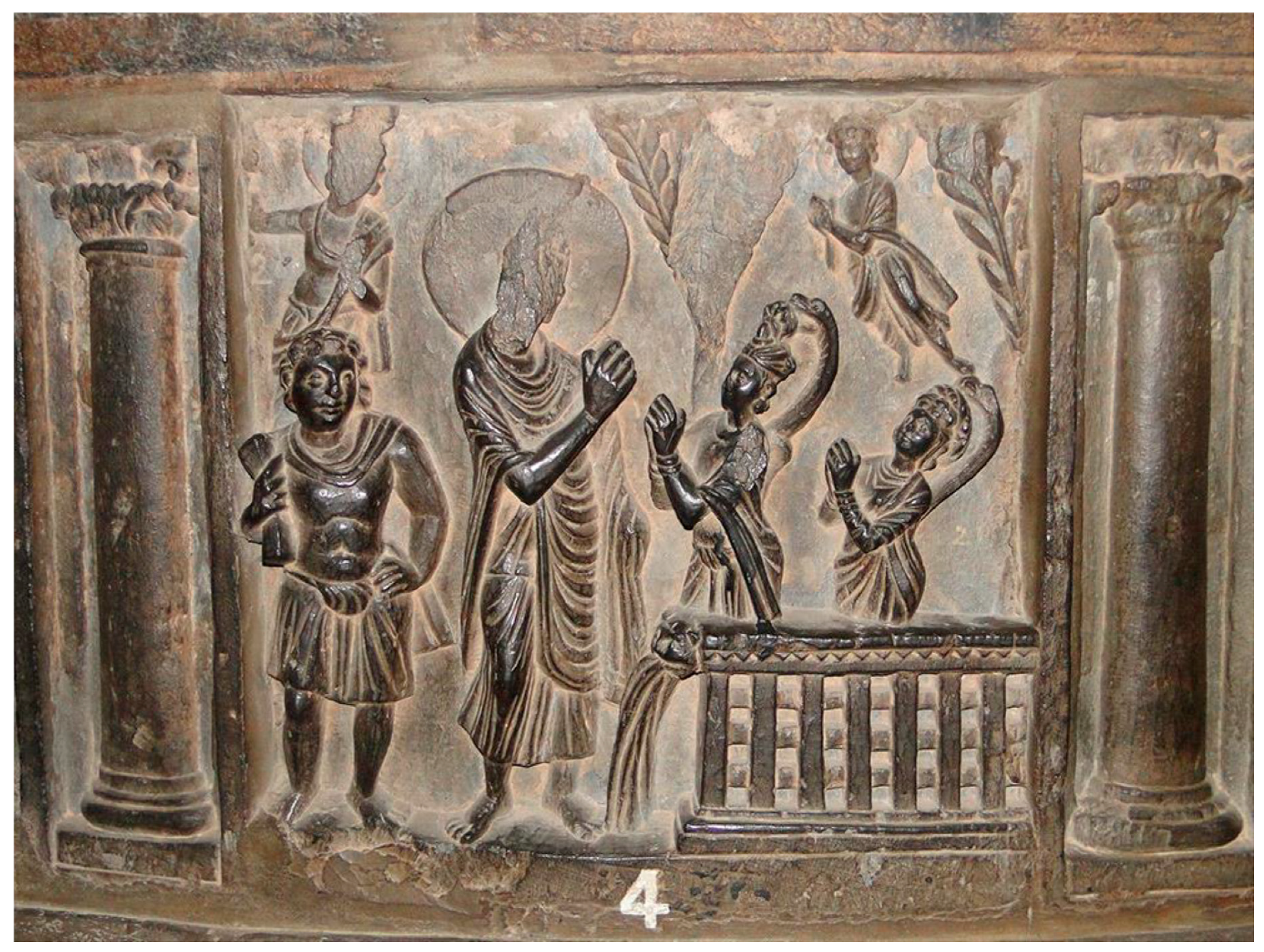
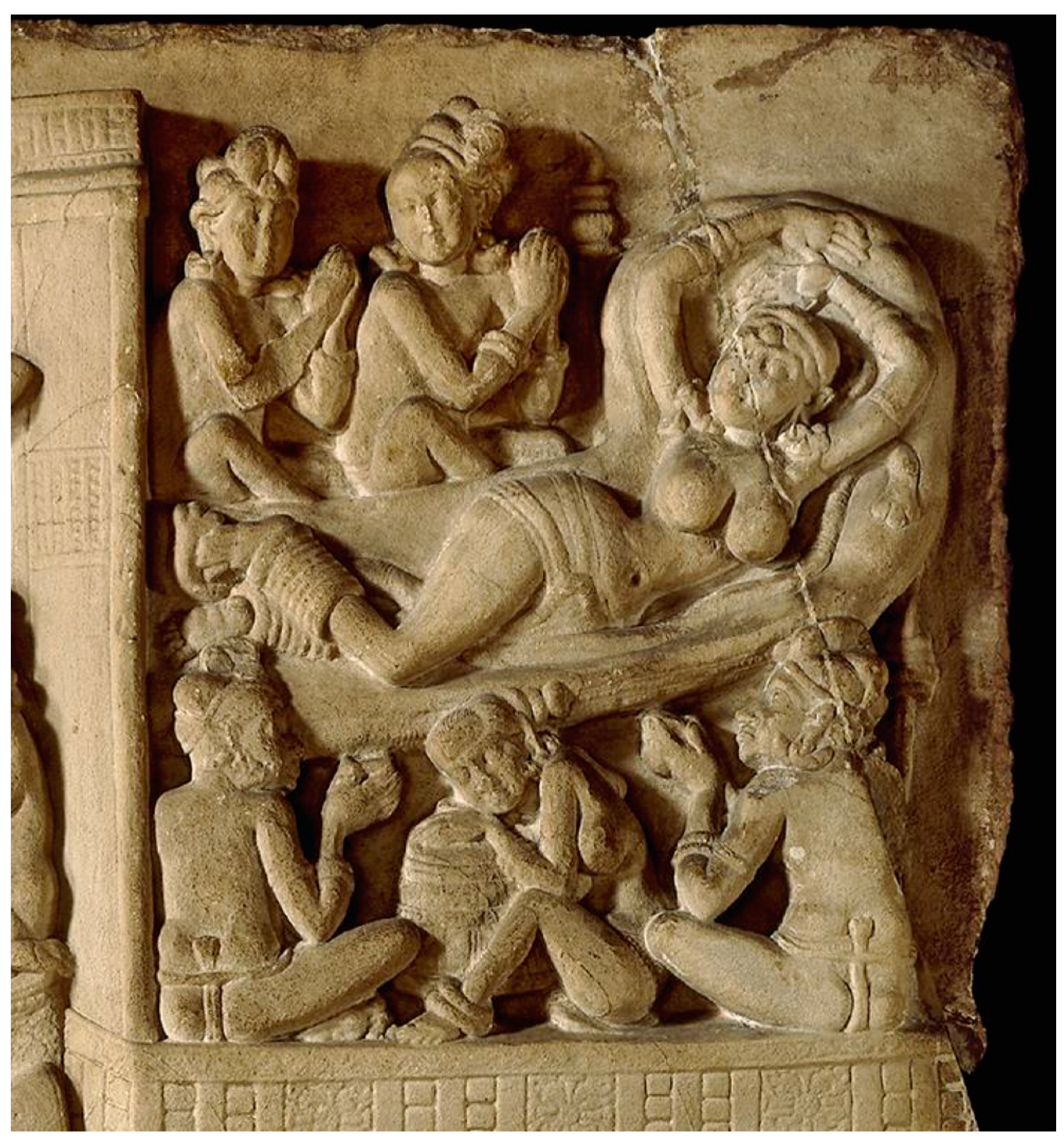
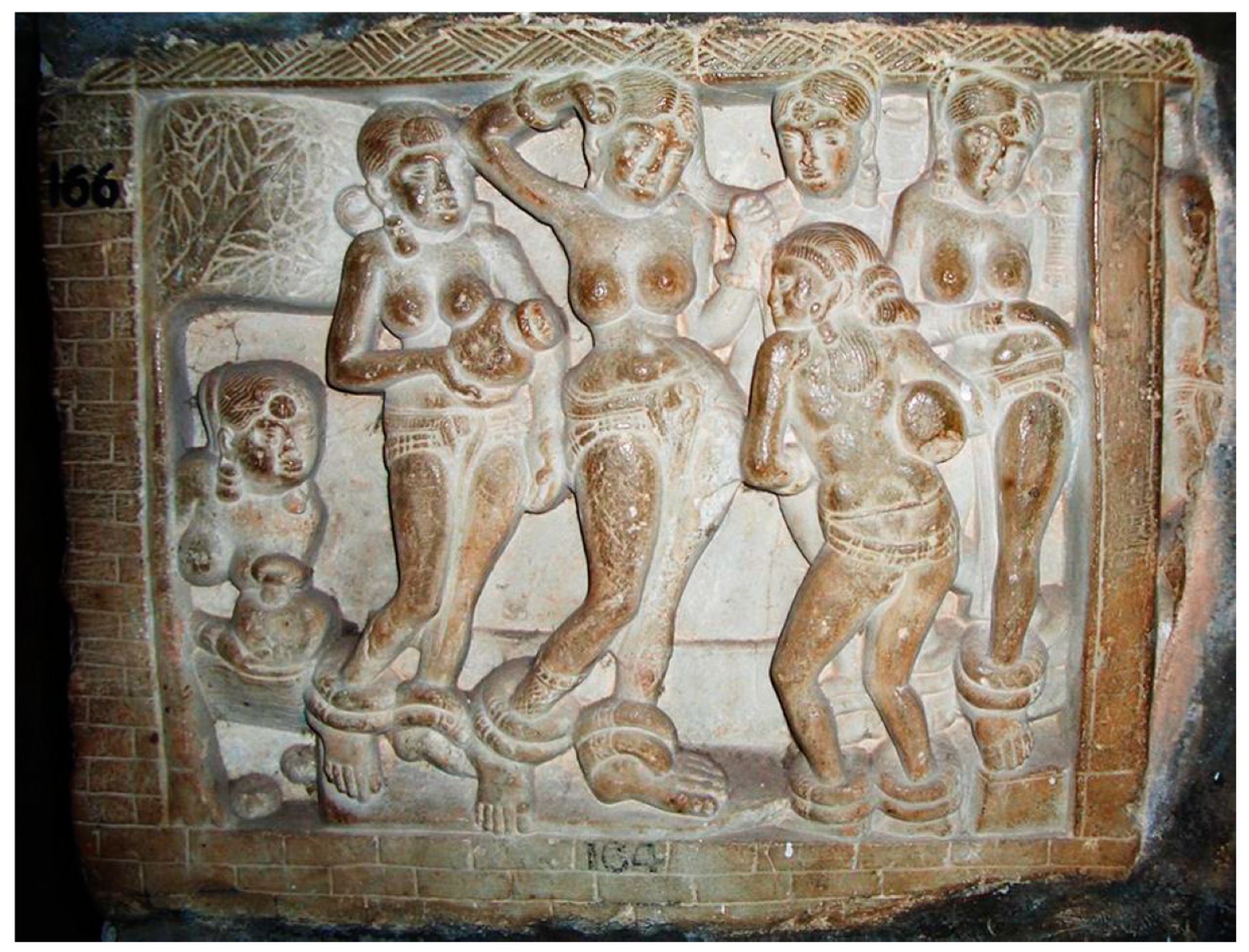

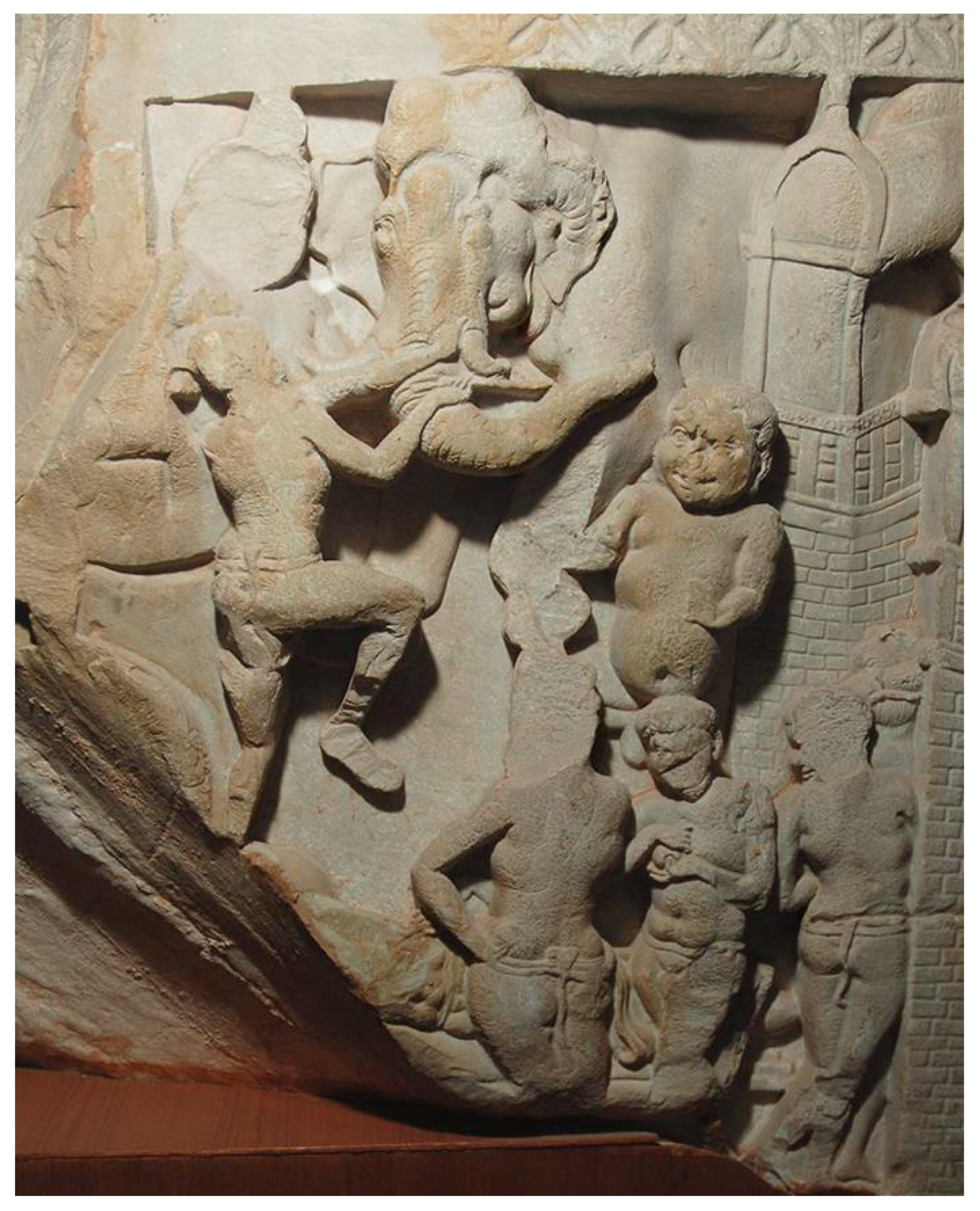
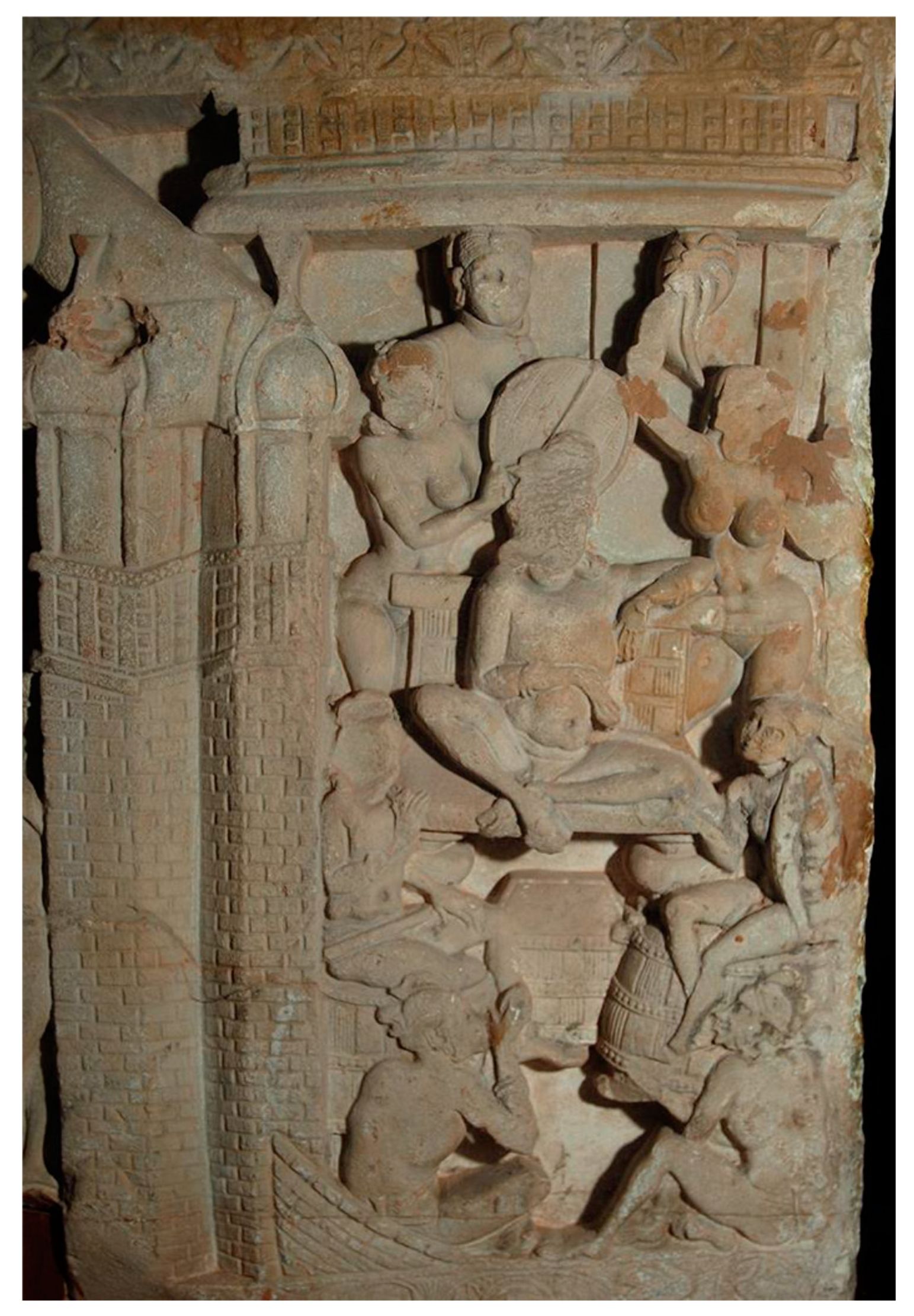
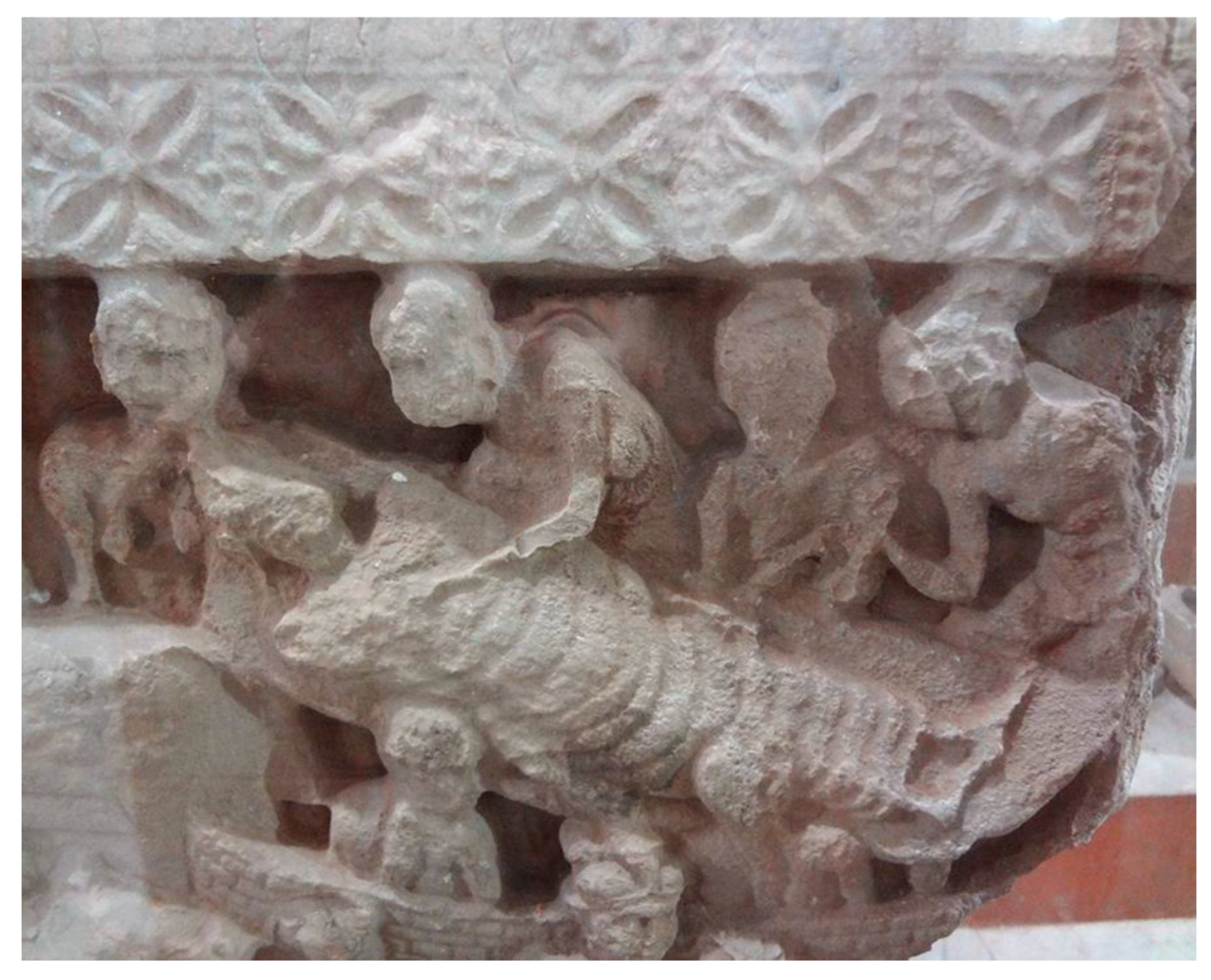
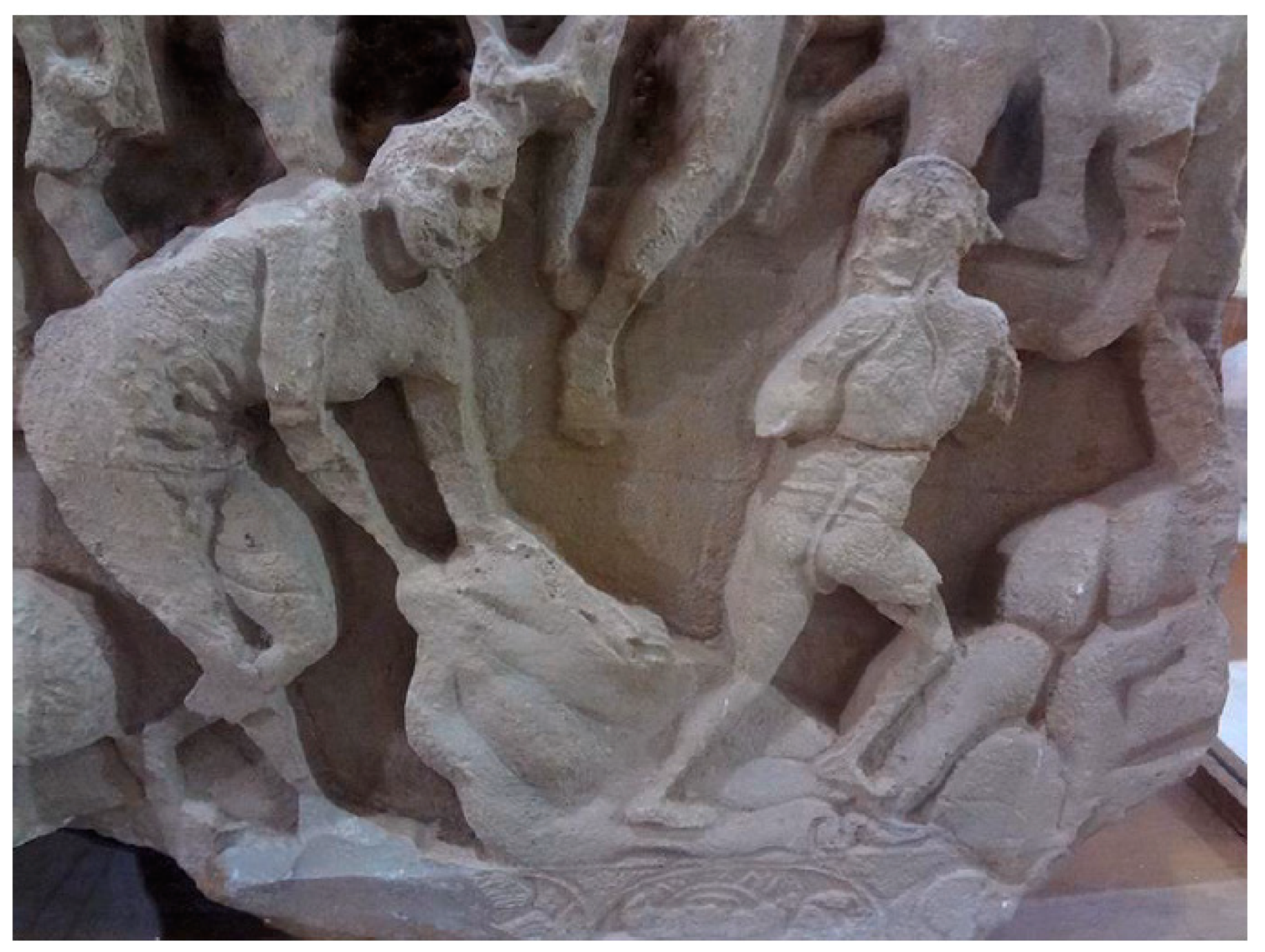
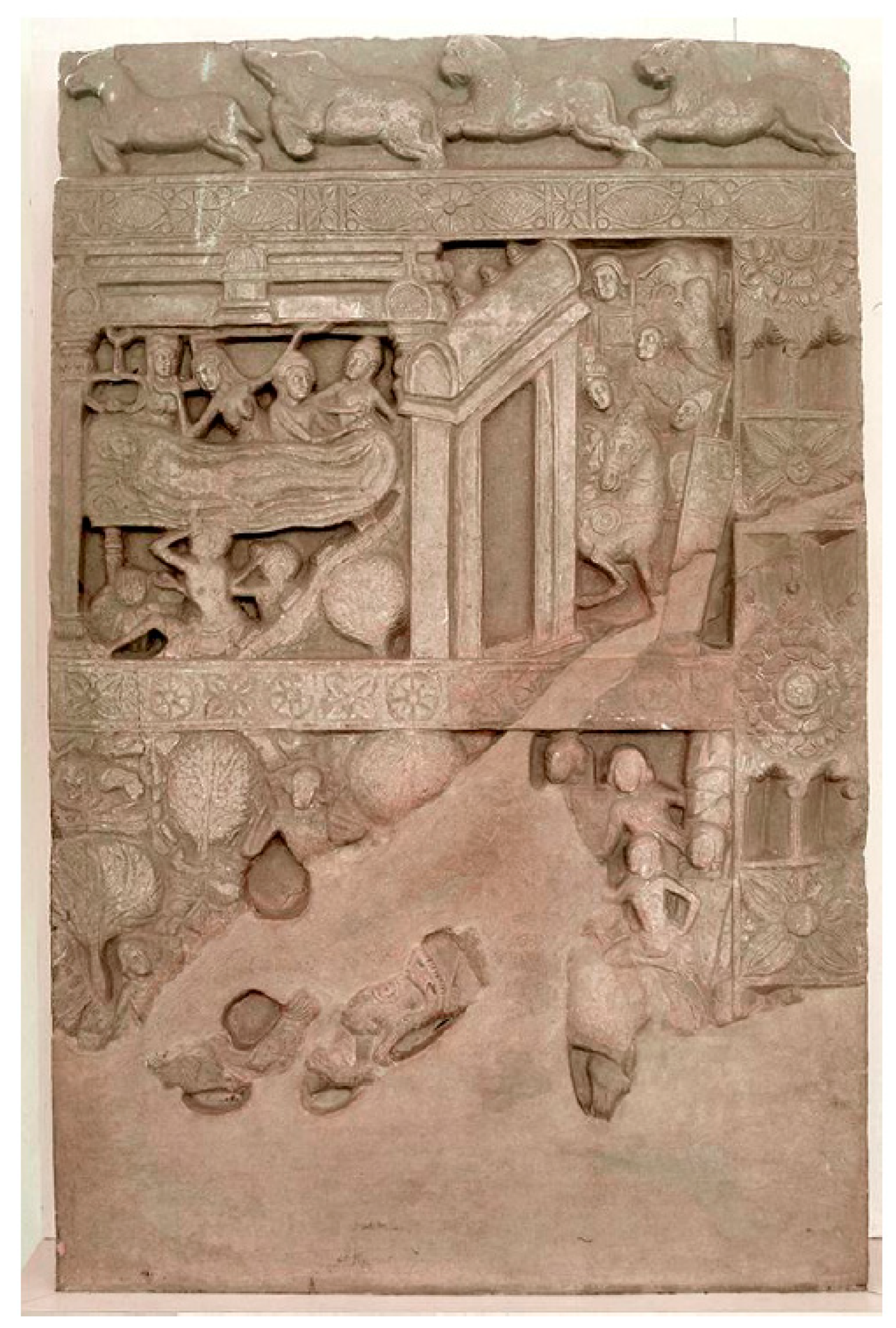
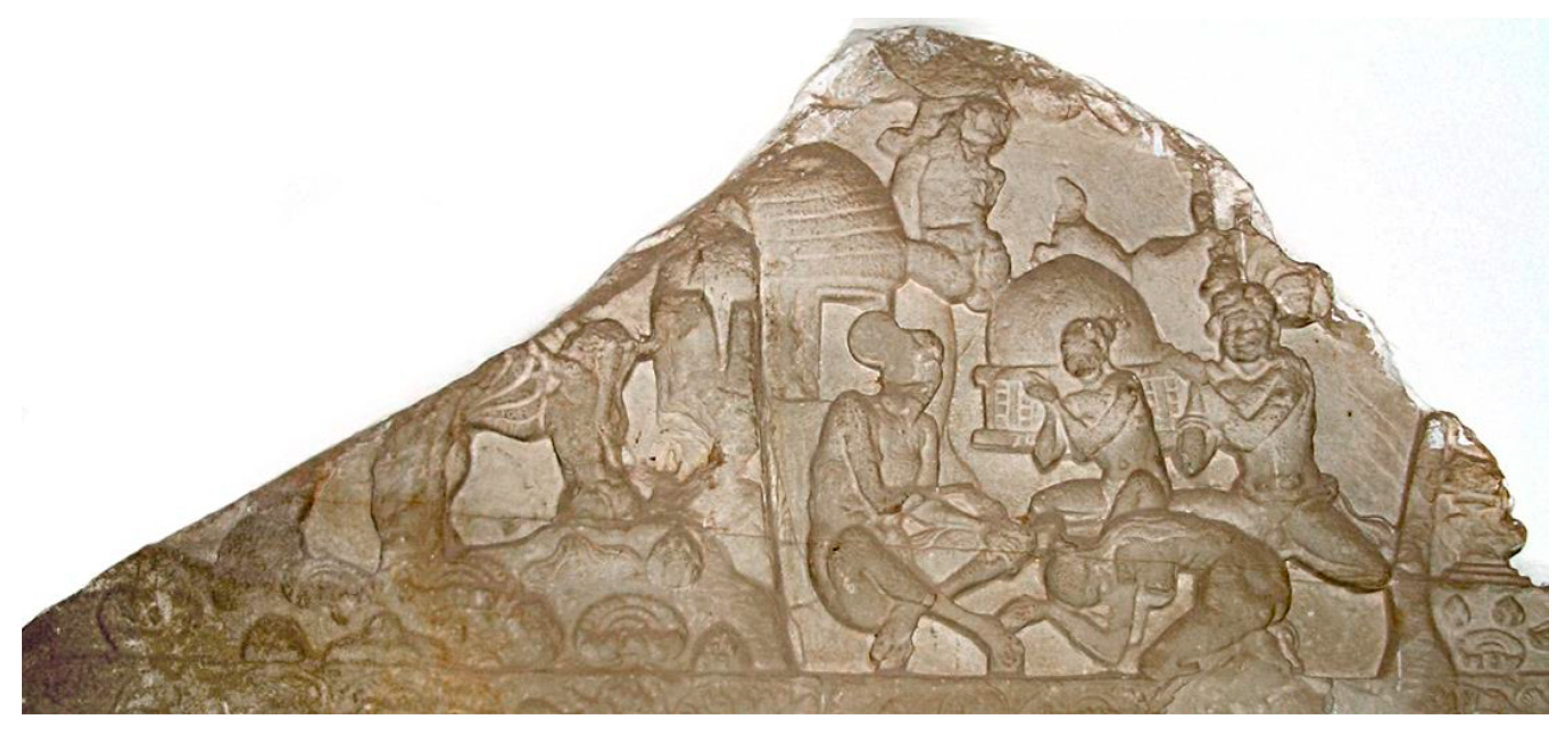
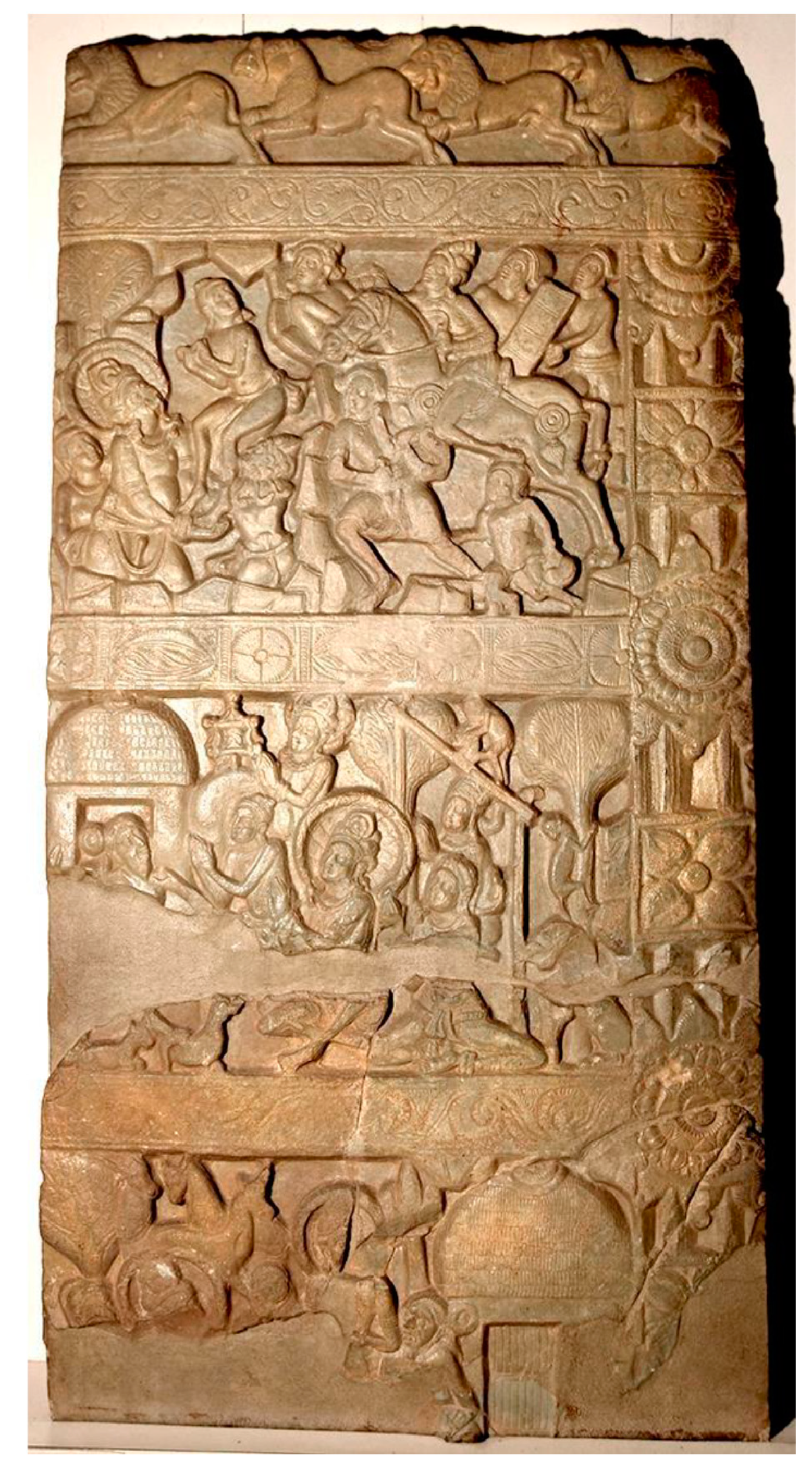
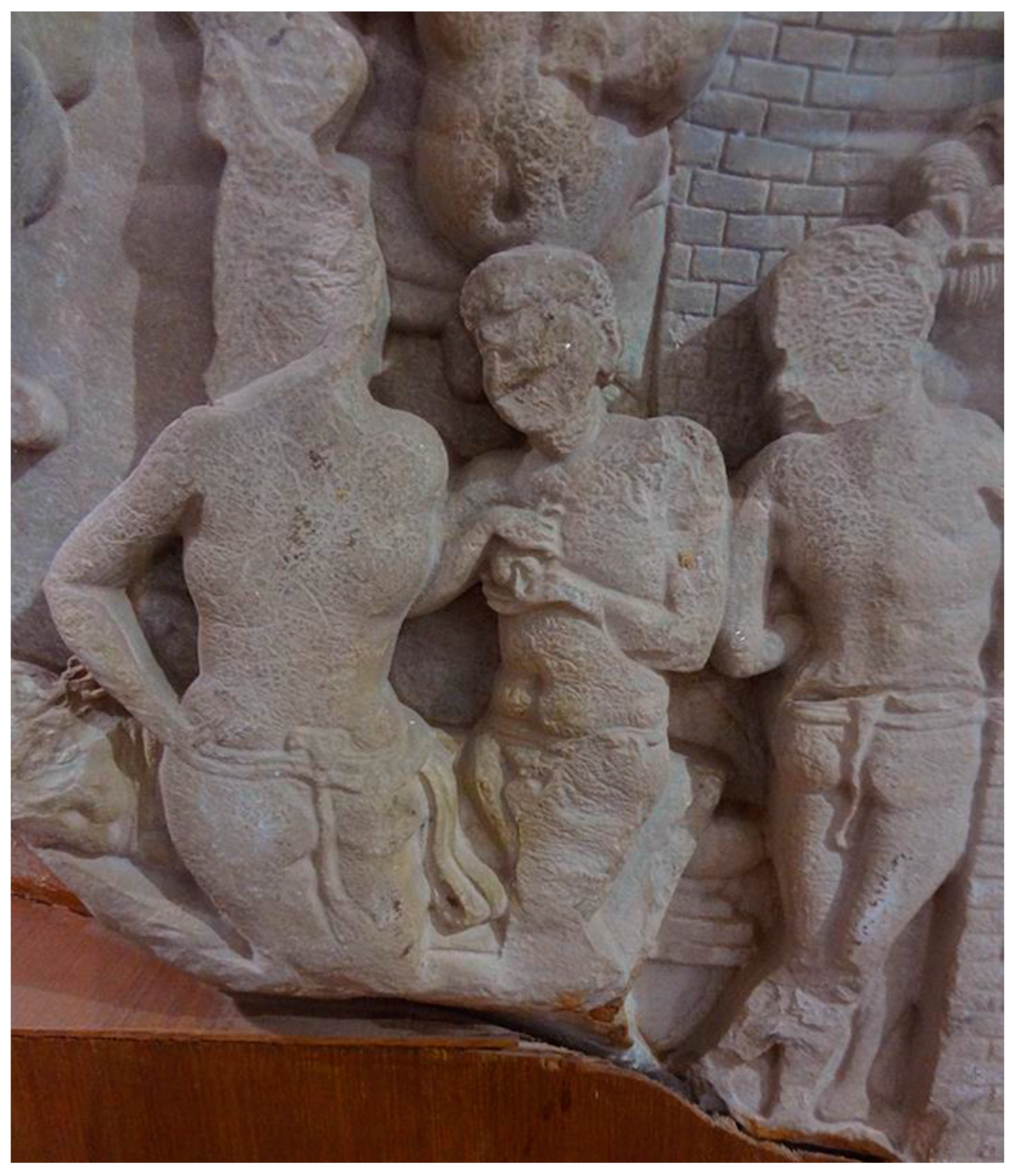
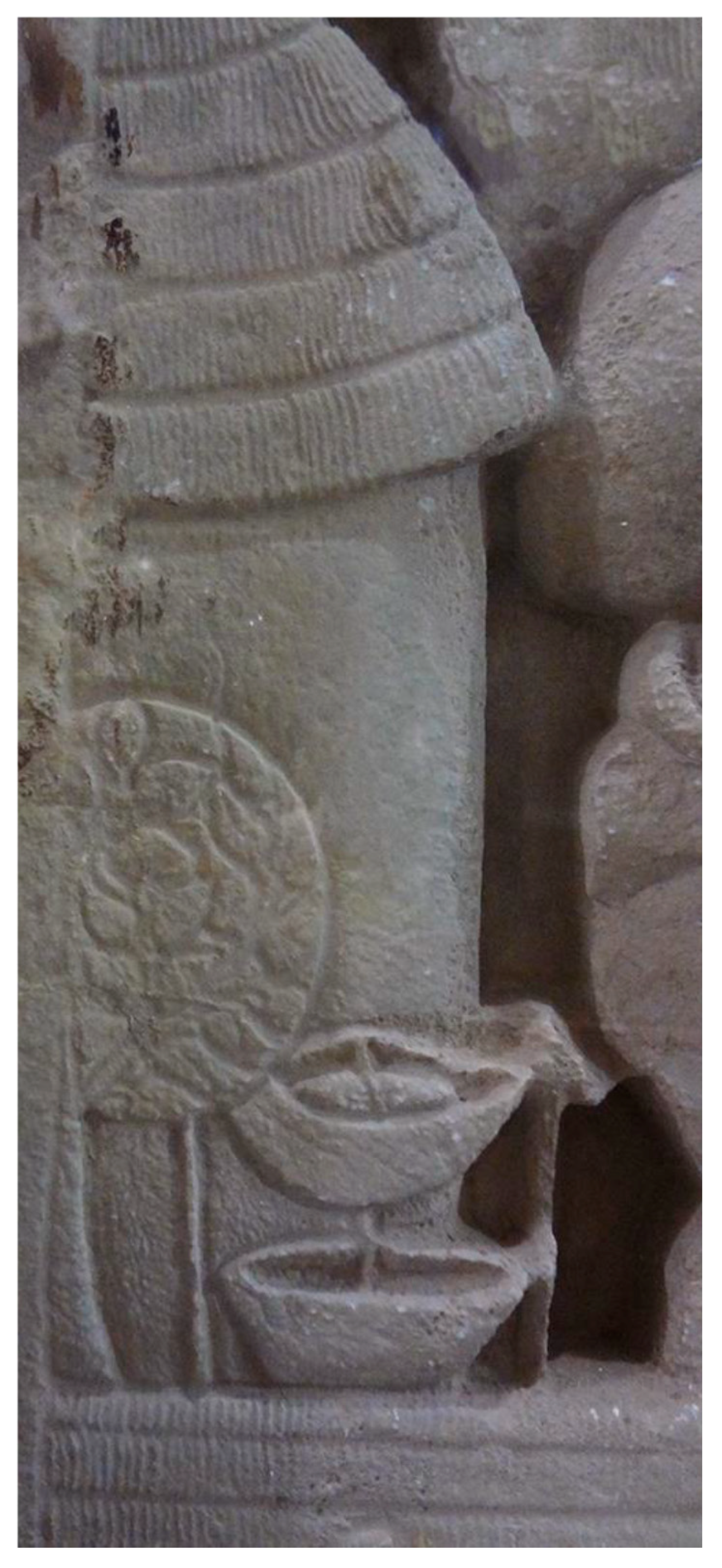
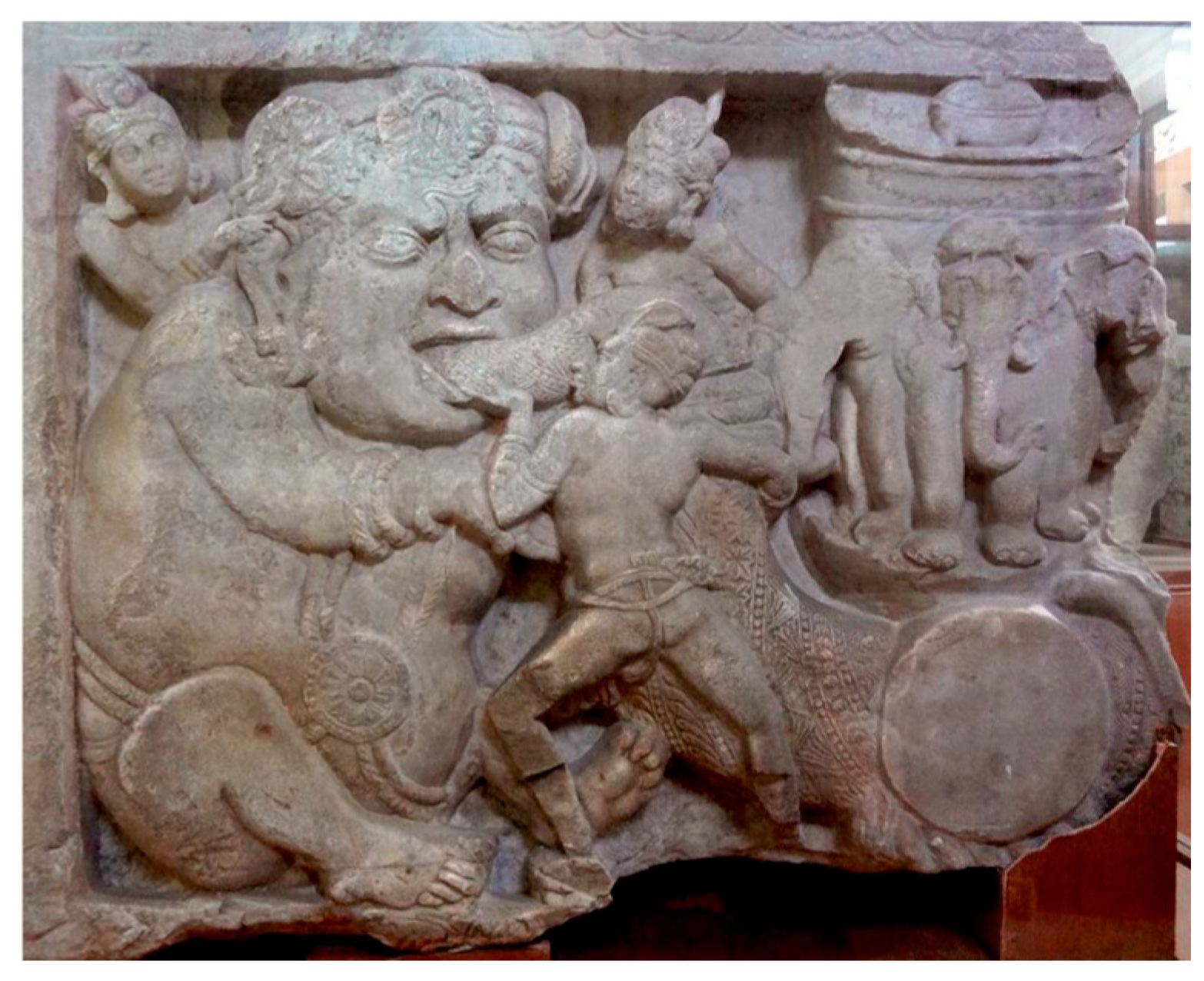
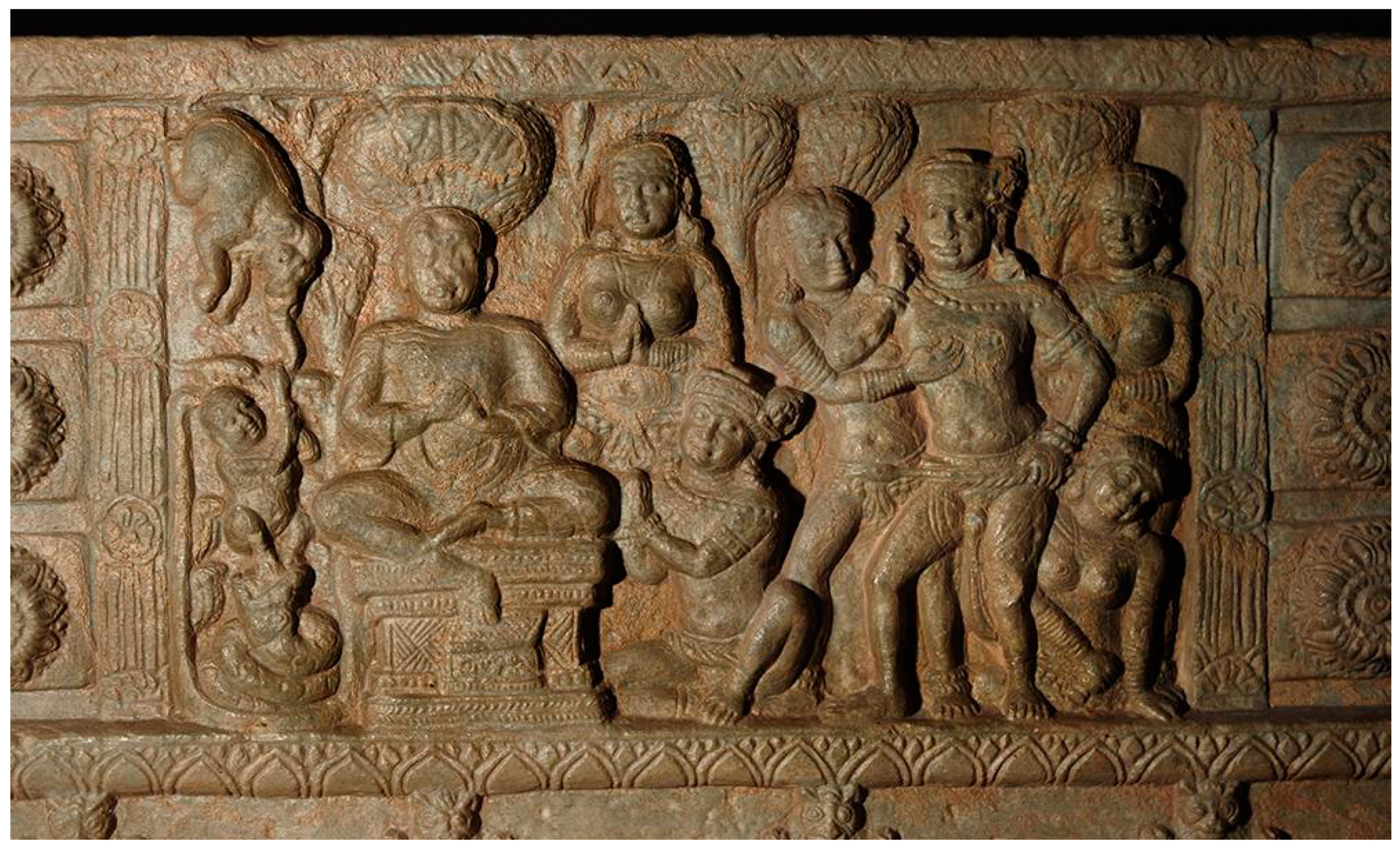
© 2020 by the author. Licensee MDPI, Basel, Switzerland. This article is an open access article distributed under the terms and conditions of the Creative Commons Attribution (CC BY) license (http://creativecommons.org/licenses/by/4.0/).
Share and Cite
Zin, M. Traces of Reciprocal Exchange: From Roman Pictorial Models to the World’s Earliest Depictions of Some Narrative Motifs in Andhra Reliefs. Religions 2020, 11, 103. https://doi.org/10.3390/rel11030103
Zin M. Traces of Reciprocal Exchange: From Roman Pictorial Models to the World’s Earliest Depictions of Some Narrative Motifs in Andhra Reliefs. Religions. 2020; 11(3):103. https://doi.org/10.3390/rel11030103
Chicago/Turabian StyleZin, Monika. 2020. "Traces of Reciprocal Exchange: From Roman Pictorial Models to the World’s Earliest Depictions of Some Narrative Motifs in Andhra Reliefs" Religions 11, no. 3: 103. https://doi.org/10.3390/rel11030103
APA StyleZin, M. (2020). Traces of Reciprocal Exchange: From Roman Pictorial Models to the World’s Earliest Depictions of Some Narrative Motifs in Andhra Reliefs. Religions, 11(3), 103. https://doi.org/10.3390/rel11030103



